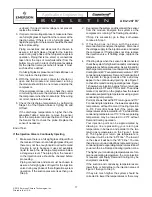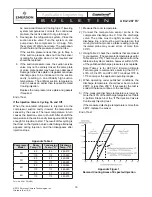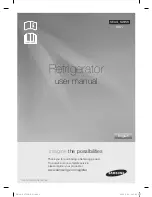
4
© 2012 Emerson Climate Technologies, Inc.
Printed in the U.S.A.
AE4-1287 R7
Application Engineering
B
U
L
L
E
T
I
N
Introduction
HCFC-22, when used in a properly designed and
controlled refrigeration system, is a realistic low
temperature refrigerant alternative to CFC-502, which
has been phased out due to its high ozone depletion
potential. However, experience has shown that
HCFC-22 can present problems as a low temperature
refrigerant because under some conditions the internal
compressor discharge temperature exceeds the safe
temperature limit for long term stability of refrigeration
oil. Other refrigerants such as HFC-407A, HFC-407C
and HFC-407F also have these characteristics.
CAUTION
POE must be handled carefully and the proper
protective equipment (gloves, eye protection, etc.)
must be used when handling POE lubricant. POE
must not come into contact with any surface or
material that might be harmed by POE, including
without limitation, certain polymers (e.g. PVC/CPVC
and polycarbonate).
The Demand Cooling
™
system (see
Figure 1
at the
end of this bulletin) uses modern electronics to provide
a reliable cost effective solution to this problem. It is
required for all single stage HCFC-22, HFC-407A,
HFC-407C and HFC-407F applications with saturated
suction temperatures below -10°F.
Demand Cooling is compatible with single (conventional)
units as well as parallel racks.
The Demand Cooling module uses the signal of
a discharge head temperature sensor to monitor
discharge gas temperature. If a critical temperature
is reached, the module energizes a long life injection
valve which meters a controlled amount of saturated
refrigerant into the compressor suction cavity to cool
the suction gas. This process controls the discharge
temperature to a safe level. If, for some reason, the
discharge temperature rises above a preset maximum
level, the Demand Cooling module will turn the
compressor off (requiring a manual reset) and actuate
its alarm contact. To minimize the amount of refrigerant
which must be injected, the suction gas cooling
process is performed after the gas has passed around
and through the motor.
Injection valve ori
fi
ces have been carefully chosen
for each body style to be large enough to provide the
necessary cooling when required but not so large
that dangerous amounts of liquid are injected, or that
excessive system pressure
fl
uctuation occurs during
injection valve cycling. Normally, pressure
fl
uctuations
are no greater than 1 to 2 psi. It is important to
use the correct valve for each compressor body style.
Performance data for Demand Cooling compressors
includes the effects of injection when it is
required. The approximate conditions where injection
occurs are shown in
Figures 2
and
3
. At the conditions
where Demand Cooling is operating, the performance
values are time averages of the instantaneous values,
since small
fl
uctuations in suction and discharge
conditions occur as the Demand Cooling injection
valve cycles.
While the refrigerant injection concept has been
widely recognized for some time, its application has
not been widely used since the early 1960’s because
of the widespread availability of CFC-502, reduction
of capacity and ef
fi
ciency, and poor reliability of injection
systems.
The Demand Cooling system addresses the
capacity and ef
fi
ciency issues by limiting injection
to those times when it is required to control discharge
temperatures to safe levels. For most applications this will
only be during periods of high condensing temperatures,
high return gas temperatures, or abnormally low
suction pressure. The Demand Cooling system
has been designed to meet the same high reliability
standards as Discus compressors.
In most cases, with
fl
oating head systems where
condensing temperatures are low during most of the
year, Demand Cooling will operate primarily as a
compressor protection control much as the oil failure
control protects the compressor during periods of low
oil pressure. Demand Cooling will be called to operate
only during those periods when condensing
temperatures and return gas temperatures are high
or in periods where a system failure (such as an iced
evaporator, an expansion valve which does not control
superheat, blocked condenser, or a failed condenser
fan) raises condensing temperatures or return gas
temperatures to abnormally high levels or lowers suction
pressure to abnormally low levels.
Operating Range
Demand Cooling is designed to protect the
compressor from high discharge temperatures over
the evaporating and condensing temperature ranges
shown in
Figures 2
and
3
. For information on head fan
requirements or other return gas conditions, contact
your Application Engineer.
Demand Cooling System Design
When Demand Cooling operates, it “diverts”




































